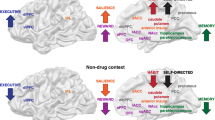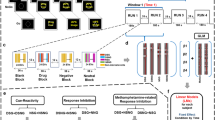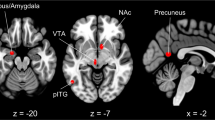Abstract
The construct of craving has been central to addiction research for more than 50 years. Only recently have investigators begun to apply functional neuroimaging techniques to the study of drug cue reactivity, and a small but growing number of studies implicate a distributed system of brain regions in the pathogenesis of craving. The internal consistency of this burgeoning literature has thus far been disappointing, however, leaving open the question of which brain regions contribute to craving. Here we review neuroimaging studies of cue-elicited craving in the context of a framework drawn from behavioral research indicating that perceived drug use opportunity significantly affects responses to the presentation of drug cues. Using this framework provides a way to reconcile discrepant findings among brain-imaging studies of cue-elicited craving.
This is a preview of subscription content, access via your institution
Access options
Subscribe to this journal
Receive 12 print issues and online access
$209.00 per year
only $17.42 per issue
Buy this article
- Purchase on Springer Link
- Instant access to full article PDF
Prices may be subject to local taxes which are calculated during checkout

Similar content being viewed by others
References
Drummond, D.C. What does cue-reactivity have to offer clinical research? Addiction 95, S129–S144 (2000).
Carter, B.L. & Tiffany, S.T. Meta-analysis of cue-reactivity in addiction research. Addiction 94, 327–340 (1999).
Franken, I.H. Drug craving and addiction: integrating psychological and neuropsychopharmacological approaches. Prog. Neuropsychopharmacol. Biol. Psychiatry 27, 563–579 (2003).
See, R.E. Neural substrates of conditioned-cued relapse to drug-seeking behavior. Pharmacol. Biochem. Behav. 71, 517–529 (2002).
Goldstein, R.Z. & Volkow, N.D. Drug addiction and its underlying neurobiological basis: neuroimaging evidence for the involvement of the frontal cortex. Am. J. Psychol. 159, 1642–1652 (2002).
London, E.D., Ernst, M., Grant, S., Bonson, K. & Weinstein, A. Orbitofrontal cortex and human drug abuse: functional imaging. Cereb. Cortex 10, 334–342 (2000).
Jentsch, J.D. & Taylor, J.R. Impulsivity resulting from frontostriatal dysfunction in drug abuse: implications for the control of behavior by reward-related stimuli. Psychopharmacology 146, 373–390 (1999).
Maas, L.C. et al. Functional magnetic resonance imaging of human brain activation during cue-induced cocaine craving. Am. J. Psychiatry 155, 124–126 (1998).
Bonson, K.R. et al. Neural systems and cue-induced cocaine craving. Neuropsychopharmacology 26, 376–86 (2002).
Brody, A.L. et al. Brain metabolic changes during cigarette craving. Arch. Gen. Psychiatry 59, 1162–1172 (2002).
Grant, S. et al. Activation of memory circuits during cue-elicited cocaine craving. Proc. Natl. Acad. Sci. USA 93, 12040–12045 (1996).
Tapert, S.F. et al. Neural response to alcohol stimuli in adolescents with alcohol use disorder. Arch. Gen. Psychiatry 60, 727–735 (2003).
Wang, G.J. et al. Regional brain metabolic activation during craving elicited by recall of previous drug experiences. Life Sci. 64, 775–784 (1999).
Wrase, J. et al. Development of alcohol-associated cues and cue-induced brain activation in alcoholics. Eur. Psychiatry 17, 287–291 (2002).
Modell, J.G. & Mountz, J.M. Focal cerebral blood flow change during craving for alcohol measured by SPECT. J. Neuropsychiatry Clin. Neurosci. 7, 15–22 (1995).
Childress, A.R. et al. Limbic activation during cue-induced cocaine craving. Am. J. Psychiatry 156, 11–18 (1999).
Due, D.L., Huettel, S.A., Hall, W.G. & Rubin, D.C. Activation in mesolimbic and visuospatial neural circuits elicited by smoking cues: evidence from functional magnetic resonance imaging. Am. J. Psychiatry 159, 954–960 (2002).
Kilts, C.D. et al. Neural activity related to drug craving in cocaine addiction. Arch. Gen. Psychiatry 58, 334–341 (2001).
Schneider, F. et al. Subcortical correlates of craving in recently abstinent alcoholic patients. Am. J. Psychiatry 158, 1075–1083 (2001).
Garavan, H. et al. Cue-induced cocaine craving: neuroanatomical specificity for drug users and drug stimuli. Am. J. Psychiatry 157, 1789–1798 (2000).
George, M.S. et al. Activation of prefrontal cortex and anterior thalamus in alcoholic subjects on exposure to alcohol-specific cues. Arch. Gen. Psychiatry 58, 345–352 (2001).
Tapert, S.F., Brown, G.G., Baratta, M.V. & Brown, S.A. fMRI BOLD response to alcohol stimuli in alcohol dependent young women. Addict. Behav. 29, 33–50 (2004).
Daglish, M.R. et al. Changes in regional cerebral blood flow elicited by craving memories in abstinent opiate-dependent subjects. Am. J. Psychiatry 158, 1680–1686 (2001).
Wexler, B.E. et al. Functional magnetic resonance imaging of cocaine craving. Am. J. Psychiatry 158, 86–95 (2001).
Hommer, D.W. Functional imaging of craving. Alcohol Res. Health 23, 187–196 (1999).
Wertz, J.M. & Sayette, M.A. A review of the effects of perceived drug use opportunity of self-reported urge. Exp. Clin. Psychopharmacol. 9, 3–13 (2001).
Carter, B.L. & Tiffany, S.T. The cue-availability paradigm: the effects of cigarette availability on cue reactivity in smokers. Exp. Clin. Psychopharmacol. 9, 183–190 (2001).
Juliano, L.M. & Brandon, T.H. Reactivity to instructed smoking availability and environmental cues: evidence with urge and reaction time. Exp. Clin. Psychopharmacol. 6, 45–53 (1998).
Droungas, A., Ehrman, R.N., Childress, A.R. & O'Brien, C.P. Effect of smoking cues and cigarette availability on craving and smoking behavior. Addict. Behav. 20, 657–673 (1995).
Sayette, M.A. et al. Effects of smoking opportunity on cue-elicited urge: a facial coding analysis. Exp. Clin. Psychopharmacol. 11, 218–227 (2003).
Wertz, J.M. & Sayette, M.A. Effects of smoking opportunity on attentional bias in smokers. Psychol Addict Behav 15, 268–71 (2001).
Lazev, A.B., Herzog, T.A. & Brandon, T.H. Classical conditions of environmental cues to cigarette smoking. Exp. Clin. Psychopharmacol. 7, 56–63 (1999).
Zinser, M.C., Fiore, M.C., Davidson, R.J. & Baker, T.B. Manipulating smoking motivation: impact on an electrophysiological index of approach motivation. J. Abnorm. Psychol. 108, 240–254 (1999).
Dols, M., Willems, B., van den Hout, M. & Bittoun, R. Smokers can learn to influence their urge to smoke. Addict. Behav. 25, 103–108 (2000).
Field, M. & Duka, T. Cues paired with a low dose of alcohol acquire conditioned incentive properties in social drinkers. Psychopharmacology 159, 325–334 (2002).
Groenewegen, H.J. & Uylings, H.B. The prefrontal cortex and the integration of sensory, limbic and autonomic information. Prog. Brain. Res. 126, 3–28 (2000).
Krawczyk, D.C. Contributions of the prefrontal cortex to the neural basis of human decision making. Neurosci. Biobehav. Rev. 26, 631–664 (2002).
Wallis, J.D. & Miller, E.K. Neuronal activity in primate dorsolateral and orbital prefrontal cortex during performance of a reward preference task. Eur. J. Neurosci. 18, 1–13 (2003).
Balleine, B.W. & Dickinson, A. Goal-directed instrumental action: contingency and incentive learning and their cortical substrates. Neuropharmacology 37, 407–419 (1998).
Volkow, N.D. & Fowler, J.S. Addiction, a disease of compulsion and drive: involvement of the orbitofrontal cortex. Cereb. Cortex 10, 318–325 (2000).
Anton, R.F. What is craving? Models and implications for treatment. Alcohol Res. Health 23, 165–173 (1999).
Rolls, E.T. The orbitofrontal cortex and reward. Cereb. Cortex 10, 284–294 (2000).
Watanabe, M., Hikosaka, K., Sakagami, M. & Shirakawa, S. Coding and monitoring of motivational context in the primate prefrontal cortex. J. Neurosci. 22, 2391–2400 (2002).
Braus, D.F. et al. Alcohol-associated stimuli activate the ventral striatum in abstinent alcoholics. J. Neural. Transm. 108, 887–894 (2001).
Sell, L.A. et al. Activation of reward circuitry in human opiate addicts. Eur. J. Neurosci. 11, 1042–1048 (1999).
Meyer, R.E. Craving: what can be done to bring the insights of neuroscience, behavioral science and clinical science into synchrony. Addiction 95, S219–S227 (2000).
Schultz, W., Tremblay, L. & Hollerman, J.R. Reward processing in primate orbitofrontal cortex and basal ganglia. Cereb. Cortex 10, 272–284 (2000).
Tiffany, S.T. A cognitive model of drug urges and drug-use behavior: role of automatic and nonautomatic processes. Psychol. Rev. 97, 147–168 (1990).
Baker, T.B., Morse, E. & Sherman, J.E. The motivation to use drugs: a psychobiological analysis of urges. Nebr. Symp. Motiv. 34, 257–323 (1986).
Williams, S.M. Sylvius: Fundamentals of Human Neural Structure (Sinauer Associates, Sunderland, Massachusetts, USA, 2000).
Acknowledgements
This research was supported in part by grants from the National Institute on Drug Abuse to M.A.S. (R01DA10605) and J.A.F. (R01DA14103), and a Ford Foundation Predoctoral Fellowship to S.J.W.
Author information
Authors and Affiliations
Corresponding author
Ethics declarations
Competing interests
The authors declare no competing financial interests.
Rights and permissions
About this article
Cite this article
Wilson, S., Sayette, M. & Fiez, J. Prefrontal responses to drug cues: a neurocognitive analysis. Nat Neurosci 7, 211–214 (2004). https://doi.org/10.1038/nn1200
Received:
Accepted:
Published:
Issue Date:
DOI: https://doi.org/10.1038/nn1200
This article is cited by
-
Increased EEG gamma power under exposure to drug-related cues: a translational index for cue-elicited craving in METH-dependent individuals
BMC Psychiatry (2023)
-
DRD2 TaqIA polymorphism-related functional connectivity between anterior insula and dorsolateral prefrontal cortex predicts the retention time in heroin-dependent individuals under methadone maintenance treatment
European Archives of Psychiatry and Clinical Neuroscience (2023)
-
Activation of mesocorticolimbic dopamine projections initiates cue-induced reinstatement of reward seeking in mice
Acta Pharmacologica Sinica (2022)
-
Co-Occurring Obsessive–Compulsive Disorder and Compulsive Sexual Behavior: Clinical Features and Psychiatric Comorbidities
Archives of Sexual Behavior (2022)
-
Partial recovery of the left DLPFC-right insula circuit with reduced craving in abstinent heroin users: a longitudinal study
Brain Imaging and Behavior (2022)



